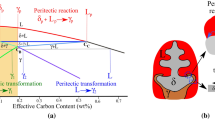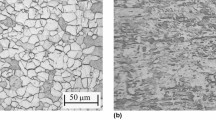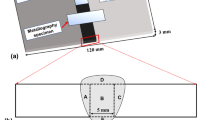Conclusions
-
1.
Alloying of steel with non-carbide forming elements (silicon, aluminum, etc.) which displace carbon from the zones in which they are abundant, increases the temperature of decomposition of martensite during tempering. These elements cause, during tempering, a vigorous redistribution of carbon displacing it towards the grain boundaries thereby increasing the susceptibility to temper (thermal) embrittlement.
-
2.
In steels alloyed with carbide-forming elements, nucleation and precipitation of cementite-type carbides can begin at the same temperatures as in carbon steel. However, at these temperatures only the part of the carbon contained in the martensite which is least firmly held by carbide-forming elements is able to participate in the carbide-forming processes. The more carbide-forming elements are present in the alloy, the larger will be the portion of carbon to precipitate in the second stage of tempering, i. e., as special carbides.
-
3.
In steels alloyed with carbide-forming elements, theα-phase remains supersaturated with carbon even after prolonged high tempering. Such compositions usually contain anα-phase supersaturated with carbon instead of equilibrium ferrite.
-
4.
At tempering temperatures at which a separation and coalescence of carbides is possible, such processes are paralleled by dissolution of carbides. Cementite-type carbides and particles of special carbides with a maximum surface-to-volume ratio, pass into solution first.
-
5.
The changes of mechanical properties of quenched alloy steels during tempering are basically controlled by the changing composition of theα-phase, by redistribution of carbon and carbide formation, and also by the transformation of retained austenite. Beyond the temperature of incipient carbide separation, the fine structure can play a noticeable role in changing the mechanical properties only when the tempering conditions cause the supersaturatedα-phase to transform into equilibrium ferrite. In this respect alloy steels differ strongly from analogous compositions with very low carbon.
-
6.
Additional proof has been obtained that the theory of temper embrittlement advanced in [12] is correct and also that temper brittleness and ‘thermal brittleness’ represent the same phenomenon.
Similar content being viewed by others
References
G. V. Kurdyumov,Zhurn. Tekhn. Fiziki, vol. 24, 1954, (7), 1254–64.
L. S. Moroz, Fine Structure and Strength of Steel (Tonkaya Struktura i Prochn. Stali), [Book] Metallurgizdat Press, 1957.
S. T. Kishkin,Izvestiya Akad. Nauk SSSR. OTN. 1946 (12), 1799–1808.
M. P. Arbuzov, L. I. Lysak and E. G. Nesterenko,Doklady Akad. Nauk SSSR, vol. 90, 1953, (3), 375–7.
G. V. Kurdyumov,Zhurn. Fizicheskoi Khimii. vol. 4, 1930, (1).
V. A. Ivensen and G. V. Kurdyumov,Zhurn. Fizicheskoi Khimii. vol. 4, 1930, (1).
G. V. Kurdyumov and N. L. Oslon,Zhurn. Tekhn. Fiziki, vol. 9, 1939, 1891–1909.
G. V. Kurdyumov and L. I. Lysak,Zhurn. Tekhn. Fiziki, vol. 16, 1946.
G. V. Kurdyumov, Problems of Metal Physics and Metallography, (Voprosy Fiziki Met. i Metallov.) Akad. Nauk Ukr. SSR Press, 1950, No. 2.
A. S. Zav'yalov and E. F. Palei, Metallovedenie [Metal, Science], Collection of Papers, Sudpromgiz Press, 1957.
A. S. Zav'yalov, Theory on Alloying and Heat Treatment of Steel, (K Teorii Legirovaniya i Term. Obrab. Stali) TsNIIKTP Press, 1943.
A. S. Zav'yalov, L. Ya. Gol'dshtein. and M. I. Senchenko, Metallovedenie, Collection of Papers, Sudpromgiz Press, 1957.
A. S. Zav'yalov and B. I. Bruk, Metallovedenie, Collection of Papers, Sudpromgiz, 1957.
A. S. Zav'yalov, Phase Transformations in Iron-Carbon Alloys, (Fazov. Prevrashch. v Zhel.-Ugler. Spl.) Sudpromgiz Press, 1948.
K. F. Starodubov,Doklady Akad. Nauk SSSR. vol. 3, 1946, (3).
L. I. Lysak, Problems of Metal Physics and Metal Science, (Voprosy Fiziki Met. i Metallov.) Akad. Nauk Ukr. SSR Press, 1952, No. 3.
G. V. Kurdyumov and L. I. Lysak,Zhurn. Tekhn. Fiz., vol. 17, 1947, 993–1002.
L. I. Lysak and L. G. Khandros, Problems of Metal Physics and Metal Science (Voprosy Fiziki Met. i Metallov.) Akad. Nauk Ukr. SSR Press, 1953, No. 4.
L. I. Lysak and E. G. Nesterenko, Problems of Metal Physics and Metal Science (Voprosy Fiziki Met. i Metallov.) Akad. Nauk Ukr. SSR, 1953, No. 4.
About this article
Cite this article
Zav'yalov, A.S., Senchenko, M.I. Effect of alloying elements on the tempering of steel. Met Sci Heat Treat 1, 3–12 (1959). https://doi.org/10.1007/BF00837028
Issue Date:
DOI: https://doi.org/10.1007/BF00837028




